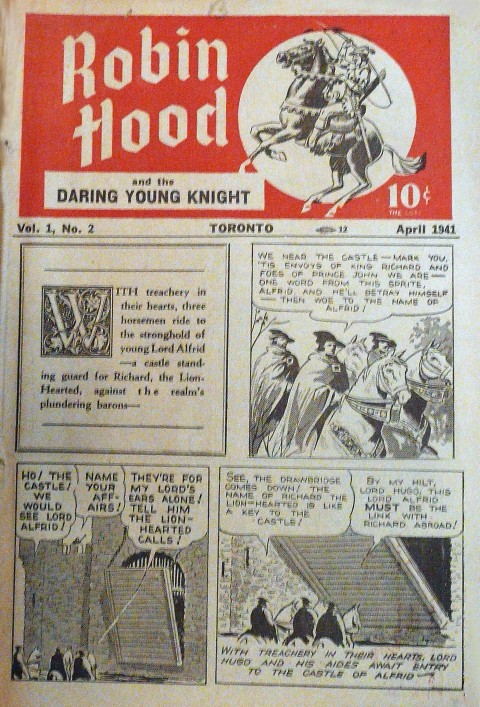
For me those comics that so many people affectionately call the “Canadian Whites” fall into a specific window whose most convenient frame is a single run of comics: Robin Hood Comics Vol. 1 No. 1 (March, 1941) to Robin Hood Comics Vol. 3 No. 34 (Dec. 1946-Jan. 1947). This is what II’vecome to term the WECA era because it was initiated by the War Exchange Conservation Act (WECA) passed Dec. 6, 1940 and came to an end as the provisions of this Act were repealed.
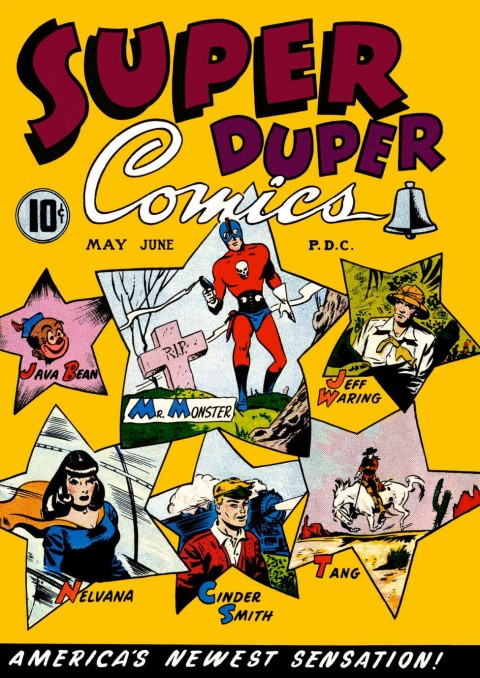
One question this raises is where do we put a book such as Super Duper Comics No. 3, which was published just outside this window in May-June 1947? This F. E. Howard book is in full-colour and has new stories featuring old Bell stars such as Nelvana, Tang, Jeff Waring, The Penguin transformed into the Blue Raven, and even the first full-length Mr. Monster story. To me, this book, even though there is continuity of characters and creators, belongs, in terms of history, to the next age of Canadian comics, the post-WECA age characterized by a new post-war legislative restriction on American imported comics that now allowed these comics to be reprinted in Canada (which the WECA period never did). This doesn’t diminish the importance of the book, nor its value, but Super Duper Comics No. 3 belongs to an already new era in Canadian comics, though I concede that arguments are solid to pull it back into the fold.
That as an aside, this week I want to examine some of the pre-history of this Robin Hood Comics run that frames the WECA period and, as most collectors of these comics know, the contents of about the first year of this run, like many of the first American comics that came out in the thirties, consists of reprints of the daily newspaper strip created and written by E. R. (Ted) McCall and drawn by Charles Reginald Snelgrove. You can find a great look at this already in John Adcock’s always well-informed and well-researched Punch in Canada blog from Feb. 2, 2009.
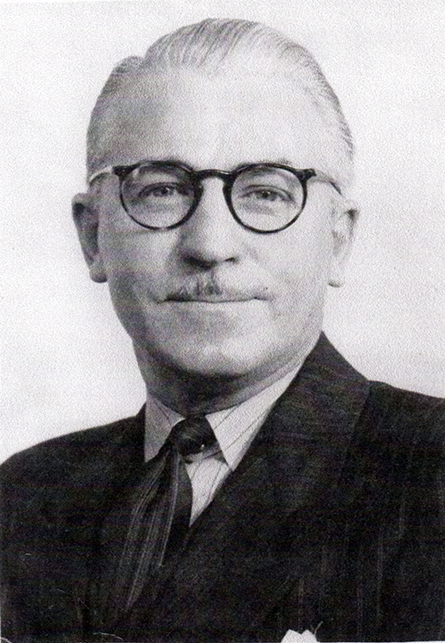
Ted McCall was born in Chatham, Ontario just three days before Christmas in 1901 to father Alexander, who established and operated McCall’s Drug Store in Chatham and originally came from Scotland and his wife Ida who was originally from Ireland. Ted first worked as a reporter in North Bay where he met his wife, Eslie Donaldson, who worked as a stenographer at the same paper and was a couple of years older than him. They married in the summer of 1922 and moved to Brantford where Ted worked on a paper there and he also worked on a paper in London, Ontario. By the thirties he was working for the Toronto Evening Telegram and the first Robin Hood and Company daily appeared on September 23, 1935 with Charles Snelgrove’s art , a full 3 years before the Warner Bros. classic The Adventures of Robin Hood (1938) which made a fantasy icon out of Errol Flynn and so McCall was riding ahead of the wave.

He went on, of course to write most of the copy for the Anglo-American Comics that weren’t licensed from Fawcett and is best known for creating arguably the most popular character of the Canadian war time comics—Freelance. He eventually went on to become Managing Editor of the Telegram but had to retire because of health issues in the early sixties. Ted McCall died from a heart attack in Toronto on November 2nd, 1975 just six weeks before his 75th birthday.
Snelgrove himself was born in Toronto on May 23, 1893 to Dentist father Charles V. Snelgrove and mother Isabella. He went to St. Andrew’s College in Aurora and then attended the Ontario College of Art, studying under John Wentworth Russell who himself began his art studies at the Hamilton School of Art–the same place where Edmond Good got his start. He served as a Captain for the Canadian Forces in the First World War and then joined the Canadian Siberian Expeditionary Force in late 1918 serving in Siberia at Omsk and in Harbin in northern China once the First World War ended. He worked for the Toronto Star as an editorial cartoonist in the 1920s and then began work at the Toronto Evening Telegram in 1932. He worked on the “Robin Hood and Company” daily strip with McCall until 1939, but by the end of 1939 he was struggling with an illness. He died on Nov. 3, 1940 at Toronto General Hospital at the age of 45.
Robin Hood and Company was reportedly syndicated in 80 newspapers but I haven’t found any evidence of it appearing in American newspapers, but it did appear, for example, in the Niagara Falls Evening Standard and possibly some other Canadian newspapers. However, it definitely appeared in the British tabloid comic The Sparkler in 1938 as well as in the Belgian comic Bravo (though its text was in Dutch) and other European comics.
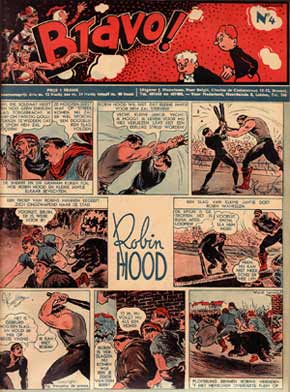
Today the most documented European reprinting of the Robin Hood and Company strip is in the online collection of the French bande dessinée L’Aventureux. I am indebted again to John Adcock for first bringing attention to these reprints this past summer in his Punch in Canada blog on Robin des Bois. You can find the start of this strip in the Vol. 2 No. 31 issue dated August 7, 1937 on line here at the gallica website. These are in French but they are in colour and reprint all the Snelgrove dailies starting with the first strip from Sept. 23, 1935 appearing in the Toronto Evening Telegram. The strip runs in L’Aventureux till about June, 1940 and then is taken over by French artists sometimes appearing with the by-line of Charles Mondel and continues into 1943.
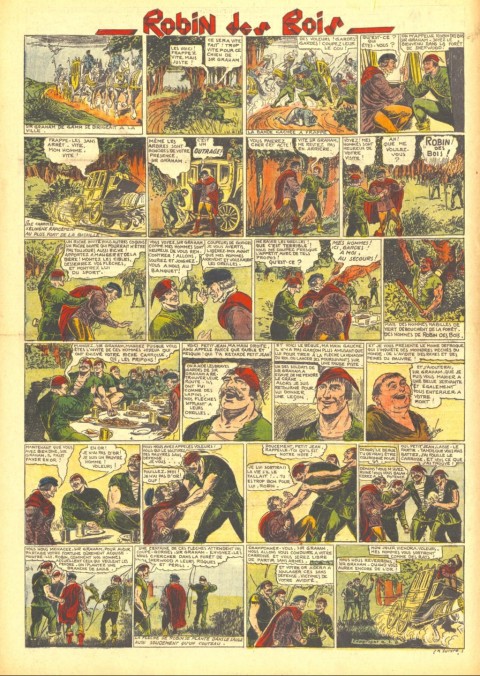
It’s a treat to see these old black-and-white strips colourized professionally with a solid register. Seeing them this way, I wonder if that should be an eventual direction when we reprint the old “Whites.” The girls (Hope and Rachel) did a great job with the Nelvana reprint (here’s the IDW reworked cover) and I look forward to the forthcoming sets (Johnny Canuck and Brock Windsor) but sometimes I think how wonderful it would be to have parallel editions with one true to the originals in black-and-white and a second with a super colourist working on them.


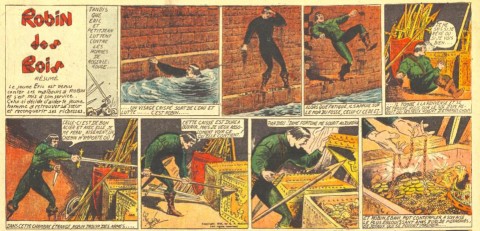
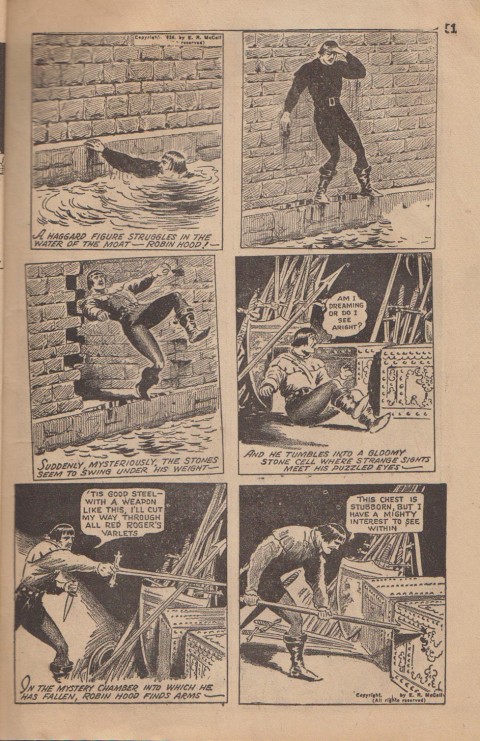


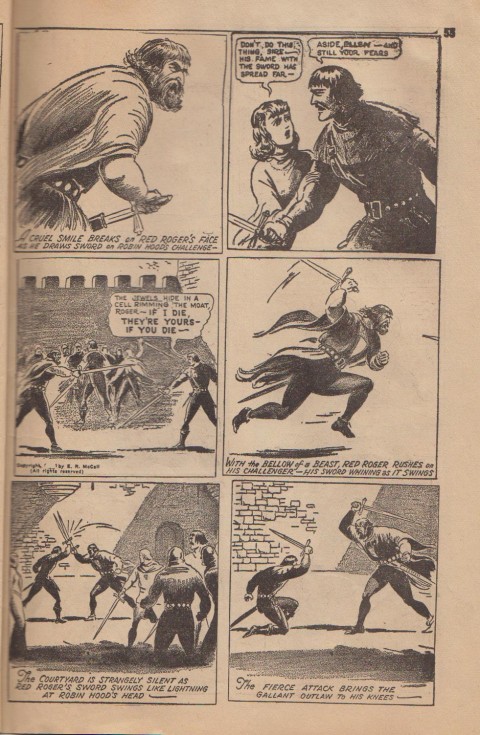
These Robin Hood strips along with Ted McCall’s other and earlier “Men of the Mounted” daily strip in The Evening Telegram, demonstrate his skill at writing good adventure stories, a skill that would be carried over into his best known Freelance comic book to make that among the best written features of the WECA period.
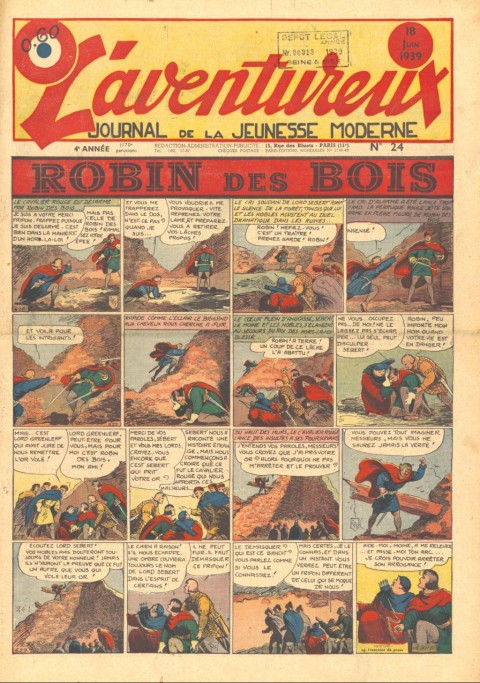
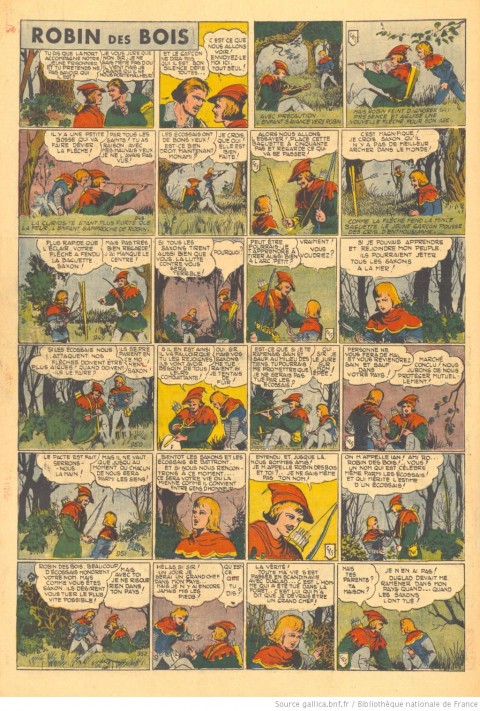
An interesting and broader look at the fictional legend of Robin Hood can be found at Allen W. Wright’s website called Robin Hood Bold Outlaw of Barnsdale and Sherwood and especially of interest is the section on Robin Hood in comic books that mentions McCall and Snelgrove’s early efforts and sees the “Hooded Man” eventually transform into Green Arrow.
———
On a final note… Sometimes Dave Sim is perceived to be an entrenched and blusterous individual but at the most important time he can be very poignant. I found out from Mel Taylor that John Balgé had passed away young and unexpectedly about a month ago. Dave and John were the backbone behind one of the best fanzines to come out of Canada in the seventies, in fact, the very early seventies. Here is Dave Sim’s tribute to John (thanks to James Waley for sending the link).
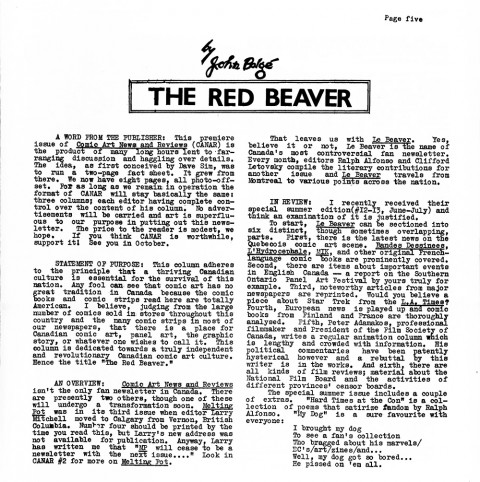
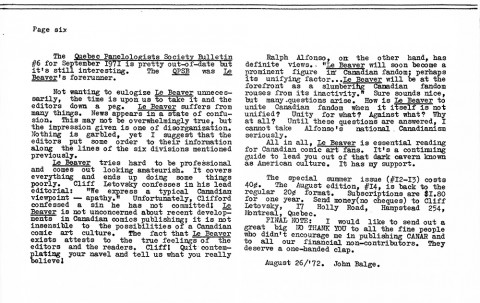

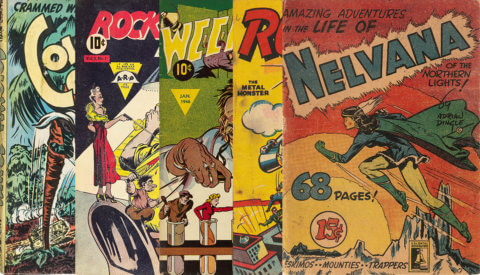
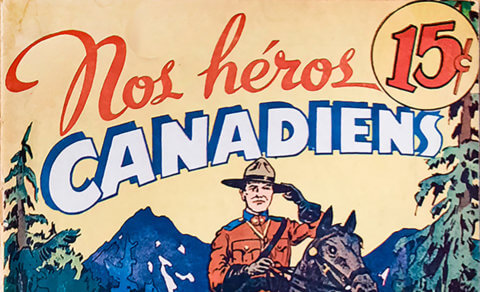
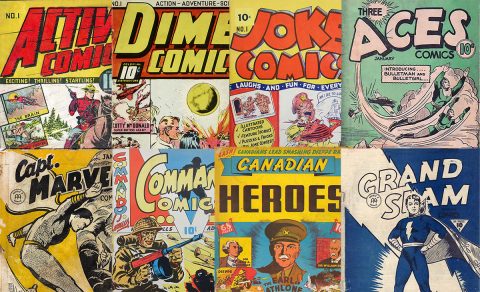
What timing! Having just bought Vol 2 #1 and Vol 3 #32, it is wonderful to read about Ted MCall. His work, to me, is some of the best in the Whites. I didn’t know he was so prolific. I find his stories, and this is not hyperbole, to be quite a bit more enjoyable than so many cliched U.S. Golden Age stories. They are more rich and complex (helped by being longer, giving a chance for more plot development) than a typical 6 or 8 page tale in an GA DC title, for instance. Like Walter mentioned in his Undervalued r\Report on Robin Hood Vol 3 #34, Ted’s writing on Men of the Mounted I also find more varied and readable, at least amng the three stories in my Robin Hood #32.
My question is, who was drawing those last color books, since Snelgrove had passed away? I see the same polished artist that I recognize in Robin Hood #32 is many of the other last Anglo-American comics, yet I checked your new WECA database and find no artist identification there either.
It’s fun to see these Robin Hood newspaper strips in full color. I might even have some of the French reprintings, since I try to nab old French compilations of strips on the rare occasions I see them. Time to dig into my collection. And keep an eye out for these. I run into French compilations more at the antiquarian books shows that I exhibit at, than at comic book shows.
But most important, I think you may be really onto something with the idea to run the new WECA compilations with newly added color rather than, or in addition to, original black & white.
I know the market will always be narrow for these. My sales on the wonderful Nelvana collection are not setting any records, though I work hard to hand-sell it whenever I can. But collecting any of the Whites in color for the first time should increase interest and make them just that much more appealing to a possibly skeptical audience. Plus not being a purist, I can say I’d enjoy them even more in color. I hope you will strongly consider this on your own project, if you can make it happen.
The ‘Double A studio’ seems to be the only answer we know at the moment for the ‘artist’ on the later Robin Hood books.
Unlike Freelance Comics which had a main artist in Ed Furness, the rest of the unsigned features (Robin Hood, Commander Steel, and so on) weren’t drawn by any one artist but by the combined efforts of the many hands of Anglo American company. You can see Robert Macmillan’s article in Canuck Comics for a brief description of this.
Thanks, Jim. Found my copy of Canuck Comics and am going out to my favorite chair and bone up on his article. I like the style, but it does all look very much like a generic take on C.C. Beck and the Fawcett “house” style. Not that it’s bad at all, since they very competently got the story across and you don’t bog down in trying to understand the artist’s intention.
Thanks, as always, for your insight and expert opinion, Bud. The tendency seems to be to put down Anglo-American comics because their heroes weren’t as flashy nor was the production on the early black and white books of the same quality as those of the other three publishers. However, this tendency also leads to the unwarranted overlooking of the solid substance of the AA books when it comes to McCall’s story telling. I think the more we find out about these books and once we do actually have a Freelance reprint book, for example, fans will give him his due.
As for the colorization, I don’t know how we would go about convincing a publisher to lay out for the cost of a parallel colorized edition for the Whites reprints, though I know I wouldn’t hesitate in buying both versions.
You’re right, Jim. I’ve talked to Robert a number of times about this and he got all his information from interviews with Ed Furness. There is still more to be gleaned from the interview material Robert still has on file with Ed.
The right person might be out there to volunteer to colorize it. For instance, both Jack Kirby romance compliations were labor-of-love projects, first by animator/artist Michel Gagne, who recently won the British equivalent of the Oscar for his work. Then another fellow came along and did the entire second boo on his own. It probably would not have been published at all, since demand for anything romance is tiny. But having the enture package ready to go, Fantagraphics couldn’t turn it down.
If I were the publisher, some investment in color costs–at least in the extra printing cost–I would consider money well spent to increase the appeal of the book.
At least the last Anglo American books are in color, so these could possibly be shot and just cleaned up.
I’m the eternal optimist, I guess. And then there is the amazing Kickstarter, to raise funds…
One thing that puzzles me is what ever became of Les Gilpin?
He came up with The Crusaders and other accomplished work in the early days of the Anglo-American comics.
There was an account that mentions he went to the U.S. to work for the C.C. Beck studio after Anglo-American stopped producing artwork and original stories in Canada, but then he just disappears. I haven’t seen anything written about him in American comics history and it would be nice to know more.
Did Gilpin actually have a hand in some of the colour Fawcett Comics that were later reprinted back up here in the Great White North?
Ivan, thanks for the shoutout to my website. Great to see a fellow Hamiltonian (my birth city) writing about Robin Hood. I’m actually working on an in-depth article on this, hoping to be completed in the Canada 150 month. I’ve read about half of the daily strips, and I have access to the last four colour Robin Hood and Company comics (I own two and have the other two digitally). And so far, I’m not seeing Maid Marian anywhere in the strip. Do you have any of vol.2 of Robin Hood Comics? Did she put in an appearance somewhere? I know there are various women who appear throughout the strips. For example, Snelgrove draws Alfrid’s betrothed Andrea in a costume highly reminiscient of De Havilland’s Maid Marian right around the time the 1938 Adventures of Robin Hood came out. It’s not completely unheard of to leave Marian out. Like Tuck, she’s mostly excluded from the ballad tradition. And Howard Pyle only made a token reference to her in his never-out-of-print children’s novel.